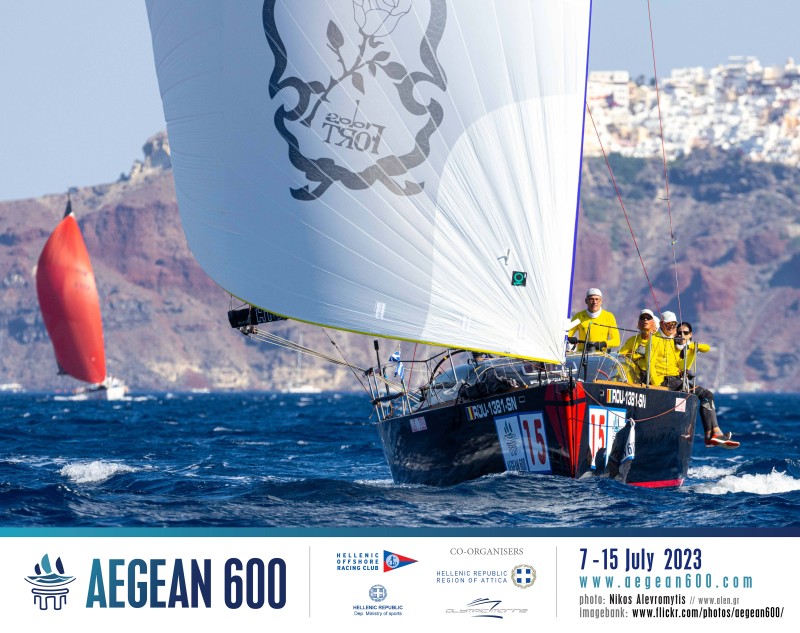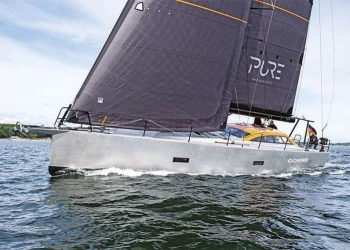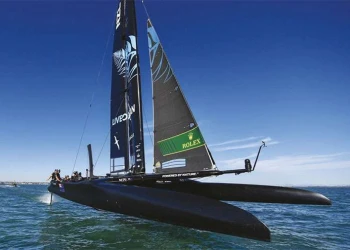
The 3,000-yearold Temple of Poseidon on Cape Sounio overlooks the start and finish lines of the the Aegean 600
The Aegean 600 has shown the Aegean is perfect for offshore racing
The Aegean is one of the best places in the world to stage an offshore race, as the Aegean 600 has shown
It’s not easy getting new offshore races organised, established and popularised in the racing community - particularly when they are held every year. Yet in only three editions since the first race was run in 2021, the Hellenic Offshore Racing Club (HORC) has done just that with the Aegean 600… prompting referral to this event as “the perfect 600- mile race.”
The race itself was conceived as a vision to attract the international racing community to what Greek offshore sailors already know: the islands and waters of the Aegean Sea are some of the best in the world for testing one’s offshore sailing skills. The conditions are idyllic: bright sun, cloudless skies and warm air and water make sunscreen and hats the most important equipment to pack.
More than just an island tour
HORC has had decades of experience organising popular annual events - like the annual Aegean Rally - that the Greek fleet has enjoyed throughout the years and given them intimate knowledge of the Aegean islands and the conditions of wind and sea throughout the region. This is the basis of their claim that the Aegean 600 is a race “designed by sailors for sailors.”
Accordingly, the racecourse they have designed is nothing less than stunning in every regard. The Aegean islands are legendary for their beauty, history and culture, and have been attracting sailors and visitors for countless generations. The Aegean 600 racecourse has thus been designed to take full advantage of this as a 605-mile anti-clockwise tour of these islands, using no less than 13 of them as official marks of the course.
Perhaps the most spectacular of these is in the first third of the race where, after leaving the Attican coast from the start off Cape Sunio and sailing past the islands at Milos (birthplace of Aphrodite and discovery of Venus de Milo), the fleet transits through the worldrenowned caldera of Santorini, where the whitewashed buildings of the island’s village lie perched hundreds of metres above the water in a spectacular natural amphitheatre. The fleet has to enter this confined enclosed space from the northwest, transit around the eroded volcanic plug that lies in its middle, and exit out the south passage en-route to the next mark of the course, the island of Kassos.
This is just one of numerous navigational challenges that face the Aegean 600 fleet: the islands on the course that need to be rounded give challenges on how to find a balance between safety, shorter distance and avoiding the windless lees from the ever-present Meltemi. Navigators have to be at the top of their game.
The Meltemi: nature’s engine for the race
Just as the ancient Greek sailors did for thousands of years, sailing the Aegean in summer is often characterised by discovering how to handle the prevailing north to northwest Meltemi winds.
Created by the confluence of high pressure conditions over the Greek mainland and a thermal low pressure over the Turkish mainland, the dry winds of the Meltemi are both welcomed for its cooling effect but also respected for its intensity, particularly in the southern regions of the race area at Kassos, Karpathos and Rhodos.
Here these winds can reach 30 or even 40kts in strength in the passages between the islands, with four to six-metre seas to accompany this strong breeze. These are the conditions the fleet encountered in the 2023 edition of the race, where headsail reaching from Kassos to Rhodos was a high-speed ride but one where helmsmen and crews had to demonstrate their seamanship and abilities to safely and prudently handle these serious conditions.
Yet, just as the Meltemi can provide respectful high speed fun and produce record-breaking conditions as it did in 2023, its absence can also cause frustration when navigators and strategists get challenged on how far to deviate off rhumb line to avoid the windless zones in the lee of the islands. And in some years, when the Meltemi is not at its full strength, playing the lee shore is actually beneficial to find local thermals that rivals further out do not enjoy. Many race leads have been lost in these areas of the course, only to be regained when teams successfully shift gears from light air Code Zeros to reefed sails once more to get around the next headland - this is a very dynamic racecourse full of challenges.
Preparation is key
To handle the challenges of the weather condition, all teams must be well prepared and ideally also well practiced to have a successful race experience. There are several ways the Aegean 600 race organisation provides assistance with this, in every respect suitable for a challenging offshore race.
First is the event’s base venue at Olympic Marine in Lavrios, where full-service, modern, world class facilities await visiting race entries. Free berthing is provided to race entries, and Olympic Marine boasts plenty of space both on their wide floating docks and in the adjacent boatyard for storage of each team’s supporting equipment and supplies.
At Olympic Marine there is outstanding personnel and support facilities for every imaginable repair and service that may be needed, from electrical systems, engines and plumbing to rigging, sails and hull and deck repairs. Parts and hardware are readily available in the chandleries and the market shop on site can meet most provisioning needs.
The marina’s cafes and restaurants also provide some shade from the Greek summer sun and a break from the hard work of preparation.
Another feature of the venue is the ample space for both the prerace meetings held in preparation for the race. This includes not only the skipper’s briefing common to all races but an authorised safety at sea seminar to ensure these skills are explained and discussed in detail to help entered teams meet their compliance with these important rules and standards.

Olympic Marine is also the site for another important feature of the Aegean 600: the numerous social events where competitors and their families and friends may enjoy a taste of the Greek culture’s famous reputation for extending outstanding hospitality to all who visit. There are even tours organised to local historical attractions, such as the 3,000-year-old ancient Temple of Poseidon that presides over the start and finish of the race from atop the spectacular sea cliffs at Cape Sounio. This unique ancient structure has tremendous significance for all who participate as a symbolic link to the past to all those countless mariners over the ages who have taken to the sea, met its challenges and returned safely.
Yet another preparation feature of the Aegean 600 is the Attica Warm-Up Race held in Stenon Makronisou, the waters immediately adjacent to Olympic Marine. This short windward-leeward race held two days prior to the start of the main event assists not only the race entries in coordinating their team work, but helps the race committee in their preparations as well.
New for 2024
The HORC organisers of the Aegean 600 are constantly improving and innovating the features of this race to meet the needs and expectations of the race’s growing fleet of participants. This includes the growing list of maxi entries since the addition of this race to the International Maxi Association’s (IMA) Mediterranean Maxi Offshore Challenge circuit of events last year. The Farr 100 Leopard 3 met this challenge in 2023 by setting a new course record of 45 hours five minutes and 25 seconds, an impressive mark to tempt others to come and have a go. For 2024 Olympic Marine has expanded to accommodate these large yachts with berthing space available for drafts up to eight metres in depth.
The Class40 class has also expressed a strong interest in participating for this next edition, being a race that is ideally suited for this style of offshore design and included the Aegean 600 in its Mediterranean Trophy racing circuit.

Berthing at Olympic Marine will be more centralised to create a congenial race village ambience, along with more pre-race social events included besides the opening and closing awards ceremonies. And in addition to the already extensive list of impressive awards offered, a new perpetual trophy has been created in honour of George Andreadis, a prominent HORC member, former Olympic athlete, offshore sailing champion, and a founding supporter of this race who passed in 2023.
Last year the fleet of IRC and ORC monohulls and multihulls grew by 25 per cent to include 45 yachts entered from 16 countries and over 500 sailors, and HORC expects similar growth for 2024. There are no better ambassadors for this growth than the participants themselves who span a wide variety of racer and cruiser/racer entries.
'What an event,’ said Chris Sherlock, skipper of Leopard 3. 'The hospitality was fantastic, the sailing was exceptional, and we look forward to coming back next year.’
'I had imagined this to be a very good race with spectacular views,’ said IRC 3 and ORC 3 class winner and Olympic medallist Panagiotis Mantis from the Hanse 508 Pheadra, 'but what I experienced was way beyond. I am thrilled and can’t wait for next year.’
Come and join the 2024 edition of the Aegean 600 and learn why this is the perfect 600-mile race and create your own legendary experience in Greek offshore sailing.





